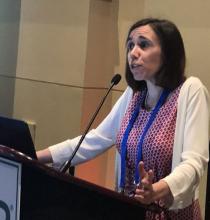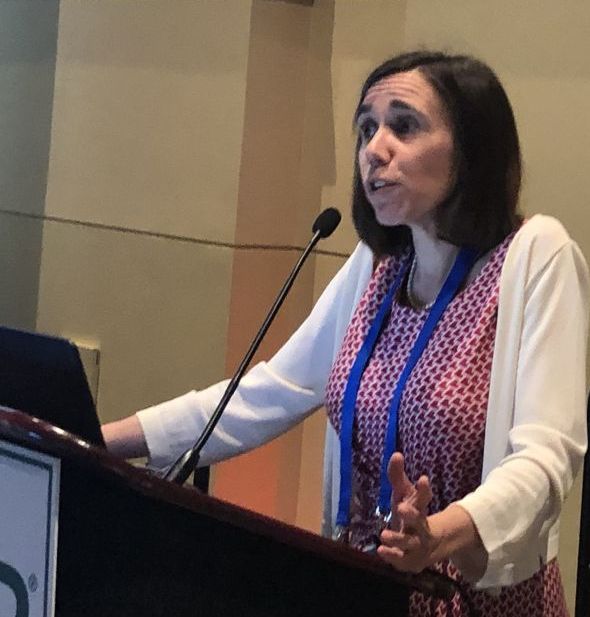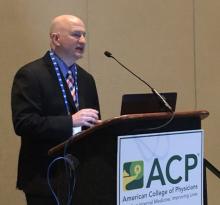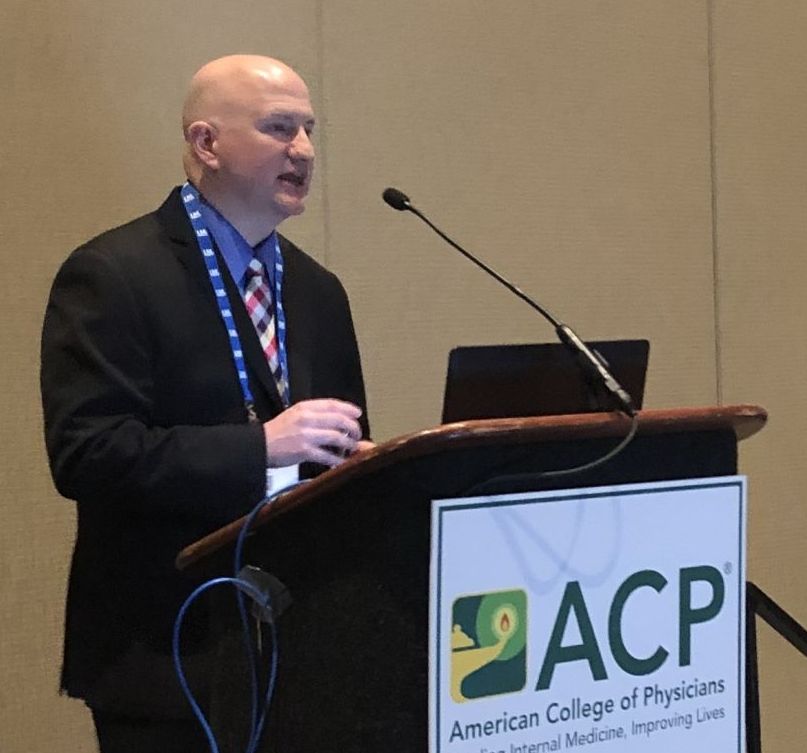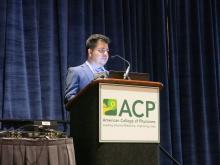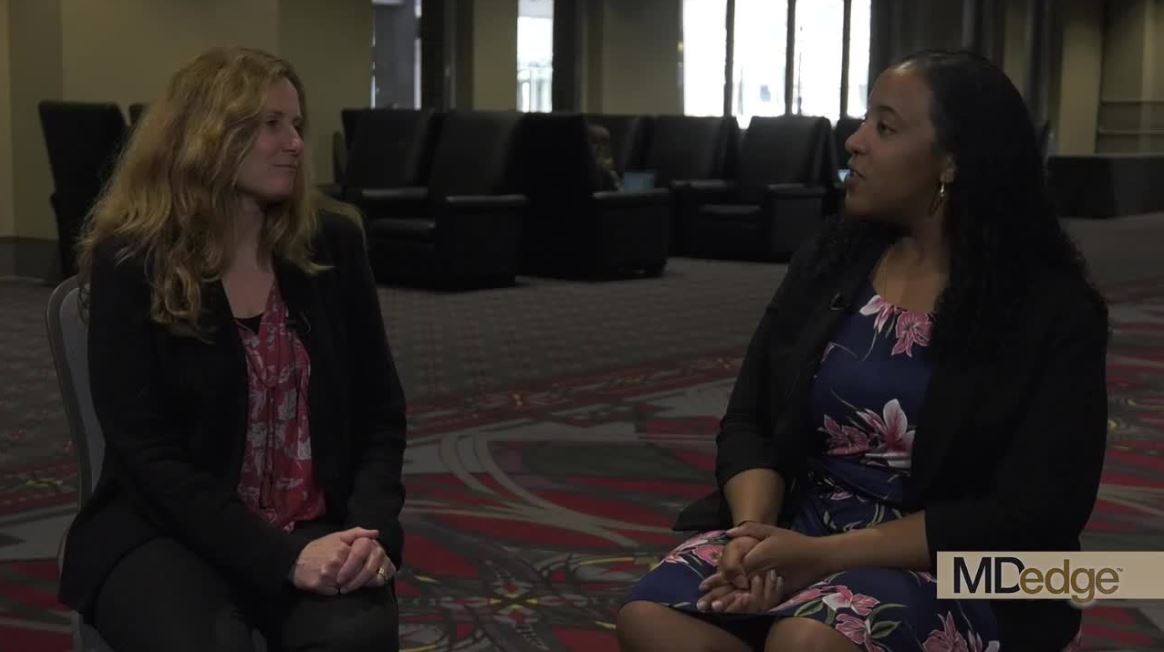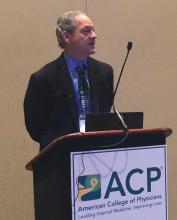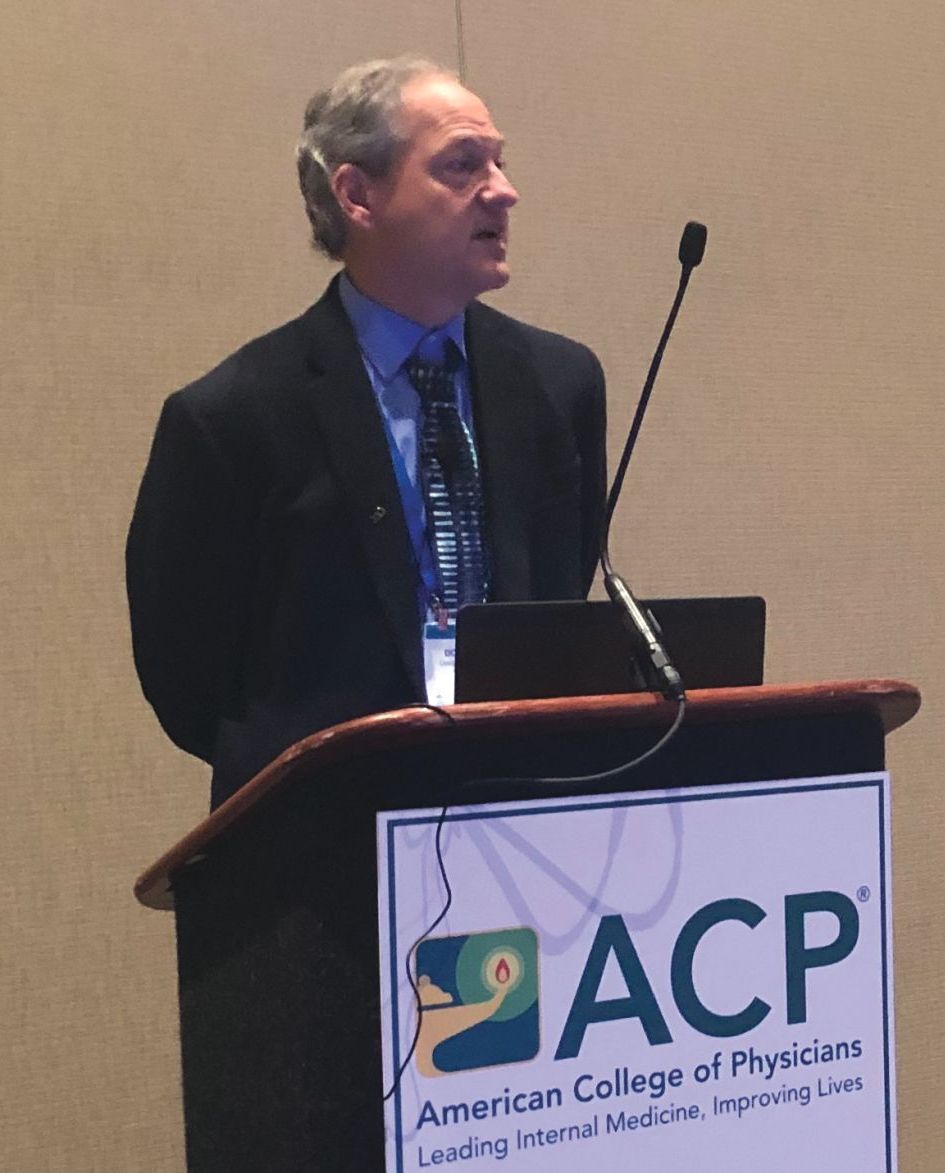User login
Volunteerism: How and why to do it, according to Dr. Eileen Barrett
PHILADELPHIA –
“I think what we get out of it is the feeling of our commitment to our sense of purpose and mission, and you just feel great when you’re giving, and then you meet these really remarkable people who do really, really remarkable things. ... It’s tremendously inspiring,” Dr. Barrett said in a video interview at the annual meeting of the American College of Physicians. She is a hospitalist at the University of New Mexico, Albuquerque, and serves on the ACP Board of Regents.
In addition, Dr. Barrett has done disaster relief work in West Africa, provided patient care to refugees in a hospital on the Thailand side of the Thailand-Myanmar border, and even helped bring organization to a public radio station in rural New Mexico.
She also described some opportunities available to internists who are trying to get their feet wet in volunteering that are available through the organizations, Health Volunteers Overseas and the Maven Project.
PHILADELPHIA –
“I think what we get out of it is the feeling of our commitment to our sense of purpose and mission, and you just feel great when you’re giving, and then you meet these really remarkable people who do really, really remarkable things. ... It’s tremendously inspiring,” Dr. Barrett said in a video interview at the annual meeting of the American College of Physicians. She is a hospitalist at the University of New Mexico, Albuquerque, and serves on the ACP Board of Regents.
In addition, Dr. Barrett has done disaster relief work in West Africa, provided patient care to refugees in a hospital on the Thailand side of the Thailand-Myanmar border, and even helped bring organization to a public radio station in rural New Mexico.
She also described some opportunities available to internists who are trying to get their feet wet in volunteering that are available through the organizations, Health Volunteers Overseas and the Maven Project.
PHILADELPHIA –
“I think what we get out of it is the feeling of our commitment to our sense of purpose and mission, and you just feel great when you’re giving, and then you meet these really remarkable people who do really, really remarkable things. ... It’s tremendously inspiring,” Dr. Barrett said in a video interview at the annual meeting of the American College of Physicians. She is a hospitalist at the University of New Mexico, Albuquerque, and serves on the ACP Board of Regents.
In addition, Dr. Barrett has done disaster relief work in West Africa, provided patient care to refugees in a hospital on the Thailand side of the Thailand-Myanmar border, and even helped bring organization to a public radio station in rural New Mexico.
She also described some opportunities available to internists who are trying to get their feet wet in volunteering that are available through the organizations, Health Volunteers Overseas and the Maven Project.
REPORTING FROM INTERNAL MEDICINE 2019
Direct-to-consumer genetic testing fraught with validity concerns
PHILADELPHIA – There are real concerns about whether today’s direct-to-consumer (DTC) genetic tests actually test the mutations they claim to test and of how well a tested DNA sequence tracks actual disease, Andrew D. Coyle, MD, said during a podium presentation at the annual meeting of the American College of Physicians.
said Dr. Coyle, assistant professor of medicine and medical education in the general internal medicine division at the Icahn School of Medicine at Mount Sinai, New York.
“I wouldn’t recommend to patients that they do [DTC testing], if they asked,” he said. “I think we probably do need to be better about asking our patients whether they’re doing this on their own, to make sure that we help them interpret it correctly, that it’s a change in risk – not a diagnosis, and not an assurance they won’t get that disease process.”
High false-positive rates have been seen in recent studies that sought to confirm genotyping data from DTC genetic test results, according to Dr. Coyle. In one 2018 study in Genetics and Medicine (2018;20:1515-21) of 49 patient samples tested for previously identified genetic variants found in raw DTC data, investigators found a 40% false positive rate, which they said underscored the importance of clinical confirmation testing to assure proper patient care, he noted.
To support his claim that many patients aren’t even telling their doctors about the DTC testing they are having done in the first place, Dr. Coyle mentioned results of a survey in Annals of Internal Medicine (2016;164[8]:513-22), which showed that only 19% of patients shared their DTC results with their primary care physicians.
He also pointed out a potential problem regarding the discussions between patients and their physicians about these test results, based on another finding reported in the paper. Of those who did tell their physicians they had DTC testing, 35% said they were “very satisfied” with how that discussion went, Dr. Coyle said.
“So they don’t tell us, and they aren’t very happy when they do tell us,” he told his audience.
The 23andMe test and the FDA
The 23andMe test, which was first directly marketed to consumers in 2006, was one of the DTC genetic tests discussed by Dr. Coyle. The Food and Drug Administration later halted the company’s Personal Genome Service in 2013 because of a lack of demonstrated clinical validity, Dr. Coyle noted.
Subsequently, the FDA classified carrier-screening tests as medical devices, allowing such services to come back, leading to what Dr. Coyle described as an explosion over the past few years of DTC evaluation of a variety of conditions, including celiac disease, Alzheimer’s disease, hemochromatosis, and then more recently, screening for cancer risk factors.
In 2018, 23andMe began offering DTC BRCA testing, but for 3 BRCA1/2 mutations seen in individuals of Ashkenazi Jewish descent, Dr. Coyle said.
“If someone did a BRCA test which is only testing three specific mutations seen mostly in Ashkenazi Jewish populations, they may be falsely reassured that the risk of breast cancer is low, when in fact they may have other BRCA mutations,” he said.
In real life, however, many people who order genetic tests online may not even act on the results. In a 2017 study in the Journal of Clinical Oncology, customers whose DTC genetic testing results showed elevated cancer risk were no more likely than were customers without elevated risk to change diet or exercise, engage in advanced planning behaviors, or get screened.
Dr. Coyle had no relevant disclosures to report.
PHILADELPHIA – There are real concerns about whether today’s direct-to-consumer (DTC) genetic tests actually test the mutations they claim to test and of how well a tested DNA sequence tracks actual disease, Andrew D. Coyle, MD, said during a podium presentation at the annual meeting of the American College of Physicians.
said Dr. Coyle, assistant professor of medicine and medical education in the general internal medicine division at the Icahn School of Medicine at Mount Sinai, New York.
“I wouldn’t recommend to patients that they do [DTC testing], if they asked,” he said. “I think we probably do need to be better about asking our patients whether they’re doing this on their own, to make sure that we help them interpret it correctly, that it’s a change in risk – not a diagnosis, and not an assurance they won’t get that disease process.”
High false-positive rates have been seen in recent studies that sought to confirm genotyping data from DTC genetic test results, according to Dr. Coyle. In one 2018 study in Genetics and Medicine (2018;20:1515-21) of 49 patient samples tested for previously identified genetic variants found in raw DTC data, investigators found a 40% false positive rate, which they said underscored the importance of clinical confirmation testing to assure proper patient care, he noted.
To support his claim that many patients aren’t even telling their doctors about the DTC testing they are having done in the first place, Dr. Coyle mentioned results of a survey in Annals of Internal Medicine (2016;164[8]:513-22), which showed that only 19% of patients shared their DTC results with their primary care physicians.
He also pointed out a potential problem regarding the discussions between patients and their physicians about these test results, based on another finding reported in the paper. Of those who did tell their physicians they had DTC testing, 35% said they were “very satisfied” with how that discussion went, Dr. Coyle said.
“So they don’t tell us, and they aren’t very happy when they do tell us,” he told his audience.
The 23andMe test and the FDA
The 23andMe test, which was first directly marketed to consumers in 2006, was one of the DTC genetic tests discussed by Dr. Coyle. The Food and Drug Administration later halted the company’s Personal Genome Service in 2013 because of a lack of demonstrated clinical validity, Dr. Coyle noted.
Subsequently, the FDA classified carrier-screening tests as medical devices, allowing such services to come back, leading to what Dr. Coyle described as an explosion over the past few years of DTC evaluation of a variety of conditions, including celiac disease, Alzheimer’s disease, hemochromatosis, and then more recently, screening for cancer risk factors.
In 2018, 23andMe began offering DTC BRCA testing, but for 3 BRCA1/2 mutations seen in individuals of Ashkenazi Jewish descent, Dr. Coyle said.
“If someone did a BRCA test which is only testing three specific mutations seen mostly in Ashkenazi Jewish populations, they may be falsely reassured that the risk of breast cancer is low, when in fact they may have other BRCA mutations,” he said.
In real life, however, many people who order genetic tests online may not even act on the results. In a 2017 study in the Journal of Clinical Oncology, customers whose DTC genetic testing results showed elevated cancer risk were no more likely than were customers without elevated risk to change diet or exercise, engage in advanced planning behaviors, or get screened.
Dr. Coyle had no relevant disclosures to report.
PHILADELPHIA – There are real concerns about whether today’s direct-to-consumer (DTC) genetic tests actually test the mutations they claim to test and of how well a tested DNA sequence tracks actual disease, Andrew D. Coyle, MD, said during a podium presentation at the annual meeting of the American College of Physicians.
said Dr. Coyle, assistant professor of medicine and medical education in the general internal medicine division at the Icahn School of Medicine at Mount Sinai, New York.
“I wouldn’t recommend to patients that they do [DTC testing], if they asked,” he said. “I think we probably do need to be better about asking our patients whether they’re doing this on their own, to make sure that we help them interpret it correctly, that it’s a change in risk – not a diagnosis, and not an assurance they won’t get that disease process.”
High false-positive rates have been seen in recent studies that sought to confirm genotyping data from DTC genetic test results, according to Dr. Coyle. In one 2018 study in Genetics and Medicine (2018;20:1515-21) of 49 patient samples tested for previously identified genetic variants found in raw DTC data, investigators found a 40% false positive rate, which they said underscored the importance of clinical confirmation testing to assure proper patient care, he noted.
To support his claim that many patients aren’t even telling their doctors about the DTC testing they are having done in the first place, Dr. Coyle mentioned results of a survey in Annals of Internal Medicine (2016;164[8]:513-22), which showed that only 19% of patients shared their DTC results with their primary care physicians.
He also pointed out a potential problem regarding the discussions between patients and their physicians about these test results, based on another finding reported in the paper. Of those who did tell their physicians they had DTC testing, 35% said they were “very satisfied” with how that discussion went, Dr. Coyle said.
“So they don’t tell us, and they aren’t very happy when they do tell us,” he told his audience.
The 23andMe test and the FDA
The 23andMe test, which was first directly marketed to consumers in 2006, was one of the DTC genetic tests discussed by Dr. Coyle. The Food and Drug Administration later halted the company’s Personal Genome Service in 2013 because of a lack of demonstrated clinical validity, Dr. Coyle noted.
Subsequently, the FDA classified carrier-screening tests as medical devices, allowing such services to come back, leading to what Dr. Coyle described as an explosion over the past few years of DTC evaluation of a variety of conditions, including celiac disease, Alzheimer’s disease, hemochromatosis, and then more recently, screening for cancer risk factors.
In 2018, 23andMe began offering DTC BRCA testing, but for 3 BRCA1/2 mutations seen in individuals of Ashkenazi Jewish descent, Dr. Coyle said.
“If someone did a BRCA test which is only testing three specific mutations seen mostly in Ashkenazi Jewish populations, they may be falsely reassured that the risk of breast cancer is low, when in fact they may have other BRCA mutations,” he said.
In real life, however, many people who order genetic tests online may not even act on the results. In a 2017 study in the Journal of Clinical Oncology, customers whose DTC genetic testing results showed elevated cancer risk were no more likely than were customers without elevated risk to change diet or exercise, engage in advanced planning behaviors, or get screened.
Dr. Coyle had no relevant disclosures to report.
EXPERT ANALYSIS FROM INTERNAL MEDICINE 2019
What is medical marijuana actually useful for?
PHILADELPHIA – , some insights into adverse effects, and “a lot of the Wild West,” Ellie Grossman, MD, MPH, said here at the annual meeting of the American College of Physicians.
The opioid-sparing effects of medical marijuana have been highlighted in recent reports suggesting that cannabis users may use less opioids, and that states with medical marijuana laws have seen drops in opioid overdose mortality, Dr. Grossman said.
“That’s kind of a story on pain and cannabinoids, and that’s really the biggest story there is in terms of medical evidence and effectiveness for this agent,” said Dr. Grossman, an instructor at Harvard Medical School and Primary Care Lead for Behavioral Health Integration, Cambridge Health Alliance, Somerville, Mass.
However, being the top story in medical marijuana may not be a very high bar in 2019, given current issues with research in this area, including inconsistencies in medical marijuana formulations, relatively small numbers of patients enrolled in studies, and meta-analyses that have produced equivocal results.
“Unfortunately, this is an area where there’s a lot of, shall I say, ‘squishiness’ in the data, through no fault of the researchers involved – it’s just an area that’s really hard to study,” Dr. Goodman said in her update on medical marijuana use at the meeting.
Most studies of cannabinoids for chronic pain have compared these agents to placebo, rather than the long list of other medications that might be used to treat pain, Dr. Grossman said.
There are several meta-analyses available, including a recently published Cochrane review in which authors concluded that, for neuropathic pain, the potential benefits of cannabis-based medicines may outweigh their potential harms.
“The upshot here is that there may be some evidence for neuropathic pain, but the evidence is generally of poor quality and kind of mixed,” said Dr. Grossman.
State-level medical cannabis laws were linked to significantly lower opioid overdose mortality rates in a 2014 study (JAMA Intern Med. 2014;174[10]:1668-73). In more recent studies, states with medical cannabis laws were found to have lower Medicare Part D opioid-prescribing rates, and in another study, legalization of medical marijuana was linked to lower rates of chronic and high-risk opioid use.
“It certainly seems like maybe we as prescribers are prescribing [fewer] opioids if there’s medical cannabis around,” Dr. Grossman said. “What this means for our patients in the short term and long term, we don’t totally know. But clearly, fewer opioid overdoses is a way better thing than more, so there could be something here.”
The cannabinoids approved by the Food and Drug Administration include nabilone (Cesamet) and dronabinol (Marinol), both synthetic cannabinoids indicated for cancer chemotherapy–related nausea and vomiting, along with cannabidiol (Epidiolex), just approved in June 2018 for treatment of some rare pediatric refractory epilepsy syndromes, Dr. Grossman said.
For chemotherapy-induced nausea and vomiting, evidence suggests oral cannabinoids are more effective than placebo, but there’s mixed evidence as to whether they are better than other antiemetics, Dr. Grossman said, while in terms of spasticity related to multiple sclerosis, research has shown small improvements in patient-reported symptoms.
Long-term adverse event data specific to medical marijuana are scant, with much of the evidence coming from studies of recreational marijuana users, Dr. Grossman said.
Those long-term effects include increased risk of pulmonary effects such as cough, wheeze, and phlegm that improve with discontinuation; case reports of unintentional pediatric ingestions; and lower neonatal birth weight, which should be discussed with women of reproductive age who are using or considering medical marijuana, Dr. Grossman said.
Motor vehicle accidents, development of psychiatric symptoms, and psychosis relapse also have been linked to use, she said.
Some real-world adverse event data specific to medical marijuana data are available through the Minnesota medical cannabis program. They found 16% of surveyed users reported an adverse event within the first 4 months, including dry mouth, fatigue, mental clouding, and drowsiness, Dr. Grossman told attendees.
Dr. Grossman reported that she has no relationship with entities producing, marketing, reselling, or distributing health care goods or services consumed by, or used on, patients.
SOURCE: Grossman E. ACP 2019, Presentation MTP 010.
PHILADELPHIA – , some insights into adverse effects, and “a lot of the Wild West,” Ellie Grossman, MD, MPH, said here at the annual meeting of the American College of Physicians.
The opioid-sparing effects of medical marijuana have been highlighted in recent reports suggesting that cannabis users may use less opioids, and that states with medical marijuana laws have seen drops in opioid overdose mortality, Dr. Grossman said.
“That’s kind of a story on pain and cannabinoids, and that’s really the biggest story there is in terms of medical evidence and effectiveness for this agent,” said Dr. Grossman, an instructor at Harvard Medical School and Primary Care Lead for Behavioral Health Integration, Cambridge Health Alliance, Somerville, Mass.
However, being the top story in medical marijuana may not be a very high bar in 2019, given current issues with research in this area, including inconsistencies in medical marijuana formulations, relatively small numbers of patients enrolled in studies, and meta-analyses that have produced equivocal results.
“Unfortunately, this is an area where there’s a lot of, shall I say, ‘squishiness’ in the data, through no fault of the researchers involved – it’s just an area that’s really hard to study,” Dr. Goodman said in her update on medical marijuana use at the meeting.
Most studies of cannabinoids for chronic pain have compared these agents to placebo, rather than the long list of other medications that might be used to treat pain, Dr. Grossman said.
There are several meta-analyses available, including a recently published Cochrane review in which authors concluded that, for neuropathic pain, the potential benefits of cannabis-based medicines may outweigh their potential harms.
“The upshot here is that there may be some evidence for neuropathic pain, but the evidence is generally of poor quality and kind of mixed,” said Dr. Grossman.
State-level medical cannabis laws were linked to significantly lower opioid overdose mortality rates in a 2014 study (JAMA Intern Med. 2014;174[10]:1668-73). In more recent studies, states with medical cannabis laws were found to have lower Medicare Part D opioid-prescribing rates, and in another study, legalization of medical marijuana was linked to lower rates of chronic and high-risk opioid use.
“It certainly seems like maybe we as prescribers are prescribing [fewer] opioids if there’s medical cannabis around,” Dr. Grossman said. “What this means for our patients in the short term and long term, we don’t totally know. But clearly, fewer opioid overdoses is a way better thing than more, so there could be something here.”
The cannabinoids approved by the Food and Drug Administration include nabilone (Cesamet) and dronabinol (Marinol), both synthetic cannabinoids indicated for cancer chemotherapy–related nausea and vomiting, along with cannabidiol (Epidiolex), just approved in June 2018 for treatment of some rare pediatric refractory epilepsy syndromes, Dr. Grossman said.
For chemotherapy-induced nausea and vomiting, evidence suggests oral cannabinoids are more effective than placebo, but there’s mixed evidence as to whether they are better than other antiemetics, Dr. Grossman said, while in terms of spasticity related to multiple sclerosis, research has shown small improvements in patient-reported symptoms.
Long-term adverse event data specific to medical marijuana are scant, with much of the evidence coming from studies of recreational marijuana users, Dr. Grossman said.
Those long-term effects include increased risk of pulmonary effects such as cough, wheeze, and phlegm that improve with discontinuation; case reports of unintentional pediatric ingestions; and lower neonatal birth weight, which should be discussed with women of reproductive age who are using or considering medical marijuana, Dr. Grossman said.
Motor vehicle accidents, development of psychiatric symptoms, and psychosis relapse also have been linked to use, she said.
Some real-world adverse event data specific to medical marijuana data are available through the Minnesota medical cannabis program. They found 16% of surveyed users reported an adverse event within the first 4 months, including dry mouth, fatigue, mental clouding, and drowsiness, Dr. Grossman told attendees.
Dr. Grossman reported that she has no relationship with entities producing, marketing, reselling, or distributing health care goods or services consumed by, or used on, patients.
SOURCE: Grossman E. ACP 2019, Presentation MTP 010.
PHILADELPHIA – , some insights into adverse effects, and “a lot of the Wild West,” Ellie Grossman, MD, MPH, said here at the annual meeting of the American College of Physicians.
The opioid-sparing effects of medical marijuana have been highlighted in recent reports suggesting that cannabis users may use less opioids, and that states with medical marijuana laws have seen drops in opioid overdose mortality, Dr. Grossman said.
“That’s kind of a story on pain and cannabinoids, and that’s really the biggest story there is in terms of medical evidence and effectiveness for this agent,” said Dr. Grossman, an instructor at Harvard Medical School and Primary Care Lead for Behavioral Health Integration, Cambridge Health Alliance, Somerville, Mass.
However, being the top story in medical marijuana may not be a very high bar in 2019, given current issues with research in this area, including inconsistencies in medical marijuana formulations, relatively small numbers of patients enrolled in studies, and meta-analyses that have produced equivocal results.
“Unfortunately, this is an area where there’s a lot of, shall I say, ‘squishiness’ in the data, through no fault of the researchers involved – it’s just an area that’s really hard to study,” Dr. Goodman said in her update on medical marijuana use at the meeting.
Most studies of cannabinoids for chronic pain have compared these agents to placebo, rather than the long list of other medications that might be used to treat pain, Dr. Grossman said.
There are several meta-analyses available, including a recently published Cochrane review in which authors concluded that, for neuropathic pain, the potential benefits of cannabis-based medicines may outweigh their potential harms.
“The upshot here is that there may be some evidence for neuropathic pain, but the evidence is generally of poor quality and kind of mixed,” said Dr. Grossman.
State-level medical cannabis laws were linked to significantly lower opioid overdose mortality rates in a 2014 study (JAMA Intern Med. 2014;174[10]:1668-73). In more recent studies, states with medical cannabis laws were found to have lower Medicare Part D opioid-prescribing rates, and in another study, legalization of medical marijuana was linked to lower rates of chronic and high-risk opioid use.
“It certainly seems like maybe we as prescribers are prescribing [fewer] opioids if there’s medical cannabis around,” Dr. Grossman said. “What this means for our patients in the short term and long term, we don’t totally know. But clearly, fewer opioid overdoses is a way better thing than more, so there could be something here.”
The cannabinoids approved by the Food and Drug Administration include nabilone (Cesamet) and dronabinol (Marinol), both synthetic cannabinoids indicated for cancer chemotherapy–related nausea and vomiting, along with cannabidiol (Epidiolex), just approved in June 2018 for treatment of some rare pediatric refractory epilepsy syndromes, Dr. Grossman said.
For chemotherapy-induced nausea and vomiting, evidence suggests oral cannabinoids are more effective than placebo, but there’s mixed evidence as to whether they are better than other antiemetics, Dr. Grossman said, while in terms of spasticity related to multiple sclerosis, research has shown small improvements in patient-reported symptoms.
Long-term adverse event data specific to medical marijuana are scant, with much of the evidence coming from studies of recreational marijuana users, Dr. Grossman said.
Those long-term effects include increased risk of pulmonary effects such as cough, wheeze, and phlegm that improve with discontinuation; case reports of unintentional pediatric ingestions; and lower neonatal birth weight, which should be discussed with women of reproductive age who are using or considering medical marijuana, Dr. Grossman said.
Motor vehicle accidents, development of psychiatric symptoms, and psychosis relapse also have been linked to use, she said.
Some real-world adverse event data specific to medical marijuana data are available through the Minnesota medical cannabis program. They found 16% of surveyed users reported an adverse event within the first 4 months, including dry mouth, fatigue, mental clouding, and drowsiness, Dr. Grossman told attendees.
Dr. Grossman reported that she has no relationship with entities producing, marketing, reselling, or distributing health care goods or services consumed by, or used on, patients.
SOURCE: Grossman E. ACP 2019, Presentation MTP 010.
AT INTERNAL MEDICINE 2019
Transformational change starts within medical practices
PHILADELPHIA –
At least one physician can attest to this.
Priya Radhakrishnan, MD, chief academic officer at HonorHealth Medical Group, Phoenix, described one of her earliest successes in working on the Transforming Clinical Practice Initiative as her literal and figurative opening of the door between a behavioral health office and a physician health office.
In her example, which she presented in a panel on transformational change at the annual meeting of the American College of Physicians, both the behavioral health office and the physician office coordinated to have the same Medicaid patients. Because of that, when the behavioral health specialist learned of a physical condition, a “warm hand-off” was made simply by walking the patient into the doctor’s office, she said.
Transformational changes in the delivery of health care can come from events and opportunities within your medical practice. And your practice data can be the tools that guide you to make the change happen, noted Dr. Radhakrishnan and her copanelists, during the April 12 session. The panelists focused their presentation on lessons learned from the ongoing Transforming Clinical Practice Initiative, a test project of the Centers for Medicare & Medicaid Services’ Center for Medicare and Medicaid Innovation. The project is providing assistance to physicians and practices looking to transform their organizations into using value-based care delivery models.
“I think most of us don’t realize how much power we hold over the ability to change health care within our neighborhood,” said Thomas Spain, MD, of Vanderbilt University Medical Center, Nashville, Tenn., during his presentation. “[We] have been lulled into this idea that health care will change ... when someone in Washington, D.C., finally makes a change.”
Actually, specific events in a single practice typically drive changes, he said. Most physicians who made these changes “really had very little interest in [practice changes]; then something would happen. It was a patient experience that they had, a family experience, a new program that came along” that made them realize there is an opportunity here for a physician to take the lead and make a change.
And, invariably, those physicians discovered “new satisfaction in their work through the process ... [their] practices looked very different at the end of the project,” Dr. Spain noted.
The other component to the success was looking differently at data to assure continuous data-driven quality improvement, said copanelist M. Carol Greenlee, MD, an endocrinologist and chair and counsel of subspecialty societies at ACP.
Data aren’t just about “being judged [and] not getting penalized,” she said. Data need to be viewed as a tool to really help understand the needs of the patient and the population.
Change makers “had to [ask], ‘For my population, how do I reduce admissions, what are the unnecessary tests my patients are getting, what are the unnecessary procedures?’ ” she said. Through the Transforming Clinical Practice Initiative, “we are teaching [participants] how to use data to show their value to payers ... and to find their voice in sharing their value.”
Some of the aims of the program included building solutions that were scalable, reducing unnecessary hospital admissions, generating $1 billion to $4 billion in savings, and transitioning 75% of practices completing the program to alternative payment models.
Dr. Spain noted that something as simple as moving the “if this is a medical emergency” disclaimer to the end of the outbound message at the physician office could help reduce trips to the emergency department. This could instead bring the patient to the office.
“Start small,” Dr. Radhakrishnan advised. “Value and quality freaks all of us out.”
Target small successes that can be built upon.
“Care delivery is the final mile,” Dr. Greenlee added. “We have all this medical knowledge, all the science and clinical research, and we know what to do with our guidelines, but if we don’t have care delivery, that final mile of [improving] ... the health of our patients, all of this is for naught.”
PHILADELPHIA –
At least one physician can attest to this.
Priya Radhakrishnan, MD, chief academic officer at HonorHealth Medical Group, Phoenix, described one of her earliest successes in working on the Transforming Clinical Practice Initiative as her literal and figurative opening of the door between a behavioral health office and a physician health office.
In her example, which she presented in a panel on transformational change at the annual meeting of the American College of Physicians, both the behavioral health office and the physician office coordinated to have the same Medicaid patients. Because of that, when the behavioral health specialist learned of a physical condition, a “warm hand-off” was made simply by walking the patient into the doctor’s office, she said.
Transformational changes in the delivery of health care can come from events and opportunities within your medical practice. And your practice data can be the tools that guide you to make the change happen, noted Dr. Radhakrishnan and her copanelists, during the April 12 session. The panelists focused their presentation on lessons learned from the ongoing Transforming Clinical Practice Initiative, a test project of the Centers for Medicare & Medicaid Services’ Center for Medicare and Medicaid Innovation. The project is providing assistance to physicians and practices looking to transform their organizations into using value-based care delivery models.
“I think most of us don’t realize how much power we hold over the ability to change health care within our neighborhood,” said Thomas Spain, MD, of Vanderbilt University Medical Center, Nashville, Tenn., during his presentation. “[We] have been lulled into this idea that health care will change ... when someone in Washington, D.C., finally makes a change.”
Actually, specific events in a single practice typically drive changes, he said. Most physicians who made these changes “really had very little interest in [practice changes]; then something would happen. It was a patient experience that they had, a family experience, a new program that came along” that made them realize there is an opportunity here for a physician to take the lead and make a change.
And, invariably, those physicians discovered “new satisfaction in their work through the process ... [their] practices looked very different at the end of the project,” Dr. Spain noted.
The other component to the success was looking differently at data to assure continuous data-driven quality improvement, said copanelist M. Carol Greenlee, MD, an endocrinologist and chair and counsel of subspecialty societies at ACP.
Data aren’t just about “being judged [and] not getting penalized,” she said. Data need to be viewed as a tool to really help understand the needs of the patient and the population.
Change makers “had to [ask], ‘For my population, how do I reduce admissions, what are the unnecessary tests my patients are getting, what are the unnecessary procedures?’ ” she said. Through the Transforming Clinical Practice Initiative, “we are teaching [participants] how to use data to show their value to payers ... and to find their voice in sharing their value.”
Some of the aims of the program included building solutions that were scalable, reducing unnecessary hospital admissions, generating $1 billion to $4 billion in savings, and transitioning 75% of practices completing the program to alternative payment models.
Dr. Spain noted that something as simple as moving the “if this is a medical emergency” disclaimer to the end of the outbound message at the physician office could help reduce trips to the emergency department. This could instead bring the patient to the office.
“Start small,” Dr. Radhakrishnan advised. “Value and quality freaks all of us out.”
Target small successes that can be built upon.
“Care delivery is the final mile,” Dr. Greenlee added. “We have all this medical knowledge, all the science and clinical research, and we know what to do with our guidelines, but if we don’t have care delivery, that final mile of [improving] ... the health of our patients, all of this is for naught.”
PHILADELPHIA –
At least one physician can attest to this.
Priya Radhakrishnan, MD, chief academic officer at HonorHealth Medical Group, Phoenix, described one of her earliest successes in working on the Transforming Clinical Practice Initiative as her literal and figurative opening of the door between a behavioral health office and a physician health office.
In her example, which she presented in a panel on transformational change at the annual meeting of the American College of Physicians, both the behavioral health office and the physician office coordinated to have the same Medicaid patients. Because of that, when the behavioral health specialist learned of a physical condition, a “warm hand-off” was made simply by walking the patient into the doctor’s office, she said.
Transformational changes in the delivery of health care can come from events and opportunities within your medical practice. And your practice data can be the tools that guide you to make the change happen, noted Dr. Radhakrishnan and her copanelists, during the April 12 session. The panelists focused their presentation on lessons learned from the ongoing Transforming Clinical Practice Initiative, a test project of the Centers for Medicare & Medicaid Services’ Center for Medicare and Medicaid Innovation. The project is providing assistance to physicians and practices looking to transform their organizations into using value-based care delivery models.
“I think most of us don’t realize how much power we hold over the ability to change health care within our neighborhood,” said Thomas Spain, MD, of Vanderbilt University Medical Center, Nashville, Tenn., during his presentation. “[We] have been lulled into this idea that health care will change ... when someone in Washington, D.C., finally makes a change.”
Actually, specific events in a single practice typically drive changes, he said. Most physicians who made these changes “really had very little interest in [practice changes]; then something would happen. It was a patient experience that they had, a family experience, a new program that came along” that made them realize there is an opportunity here for a physician to take the lead and make a change.
And, invariably, those physicians discovered “new satisfaction in their work through the process ... [their] practices looked very different at the end of the project,” Dr. Spain noted.
The other component to the success was looking differently at data to assure continuous data-driven quality improvement, said copanelist M. Carol Greenlee, MD, an endocrinologist and chair and counsel of subspecialty societies at ACP.
Data aren’t just about “being judged [and] not getting penalized,” she said. Data need to be viewed as a tool to really help understand the needs of the patient and the population.
Change makers “had to [ask], ‘For my population, how do I reduce admissions, what are the unnecessary tests my patients are getting, what are the unnecessary procedures?’ ” she said. Through the Transforming Clinical Practice Initiative, “we are teaching [participants] how to use data to show their value to payers ... and to find their voice in sharing their value.”
Some of the aims of the program included building solutions that were scalable, reducing unnecessary hospital admissions, generating $1 billion to $4 billion in savings, and transitioning 75% of practices completing the program to alternative payment models.
Dr. Spain noted that something as simple as moving the “if this is a medical emergency” disclaimer to the end of the outbound message at the physician office could help reduce trips to the emergency department. This could instead bring the patient to the office.
“Start small,” Dr. Radhakrishnan advised. “Value and quality freaks all of us out.”
Target small successes that can be built upon.
“Care delivery is the final mile,” Dr. Greenlee added. “We have all this medical knowledge, all the science and clinical research, and we know what to do with our guidelines, but if we don’t have care delivery, that final mile of [improving] ... the health of our patients, all of this is for naught.”
REPORTING FROM INTERNAL MEDICINE 2019
No clear winner for treating neuropathic pain
PHILADELPHIA – Nearly 7%-10% of the general population experiences neuropathic pain, but studies on treatments have not found a clear winner for reducing this “burning or electriclike pain,” explained Raymond Price, MD, during a presentation.
“It isn’t that exciting,” said Dr. Price, associate professor of neurology at the University of Pennsylvania, Philadelphia, in reference to his review of level 1-2 evidence for treatment of neuropathic pain that was presented in a study published in JAMA (2015 Nov 24;314[20]:2172-81). a few years ago. “On a scale of 1 to 10, you can reduce their pain scale by 1-2 points more than placebo,” he told his audience at the annual meeting of the American College of Physicians.
There are very limited head-to-head data as to which one is actually better,” he explained.
Given the absence of robust head-to-head trial data, Dr. Price tends to start a lot of patients on old, cheap medications like nortriptyline.
While there aren’t many head-to-head trials to guide treatment choice, the results of one prospective, randomized, open-label study of 333 patients with cryptogenic sensory polyneuropathy was presented by Barohn and colleagues at the 2018 annual meeting of the American Academy of Neurology, he said. In that study, somewhat higher efficacy rates were seen with duloxetine, a serotonin-noradrenaline reuptake inhibitor, and nortriptyline, a tricyclic antidepressant, compared with pregabalin, Dr. Price noted. Duloxetine and nortriptyline also had slightly better tolerability, as evidenced by a lower quit rate, compared with pregabalin, he added.
There was also a systematic review and meta-analysis (Lancet Neurol. 2015 Feb; 14[2]:162-73) conducted that determined the number needed to treat for neuropathic pain treatments, Dr. Price noted. In that paper, tricyclic antidepressants had a number needed to treat of 3.6, comparing favorably to 7.7 for pregabalin, 7.2 for gabapentin, and 6.4 for serotonin-noradrenaline reuptake inhibitors, mainly including duloxetine, said Dr. Price.
Regardless of the cause of neuropathic pain, the same general approach to treatment is taken, though most of the evidence comes from studies of patients with painful diabetic peripheral neuropathy or postherpetic neuralgia, he added.
For these patients, an adequate trial of a neuropathic pain treatment should be 6-12 weeks, reflecting the length of the intervention needed to demonstrate the efficacy of these agents, he said.
If that first drug doesn’t work, another can be tried, or multiple drugs can be tried together to see if the patient’s condition improves, he said.
Dr. Price reported no conflicts of interest.
SOURCE: Price R Internal Medicine 2019, Presentation MSFM 002.
PHILADELPHIA – Nearly 7%-10% of the general population experiences neuropathic pain, but studies on treatments have not found a clear winner for reducing this “burning or electriclike pain,” explained Raymond Price, MD, during a presentation.
“It isn’t that exciting,” said Dr. Price, associate professor of neurology at the University of Pennsylvania, Philadelphia, in reference to his review of level 1-2 evidence for treatment of neuropathic pain that was presented in a study published in JAMA (2015 Nov 24;314[20]:2172-81). a few years ago. “On a scale of 1 to 10, you can reduce their pain scale by 1-2 points more than placebo,” he told his audience at the annual meeting of the American College of Physicians.
There are very limited head-to-head data as to which one is actually better,” he explained.
Given the absence of robust head-to-head trial data, Dr. Price tends to start a lot of patients on old, cheap medications like nortriptyline.
While there aren’t many head-to-head trials to guide treatment choice, the results of one prospective, randomized, open-label study of 333 patients with cryptogenic sensory polyneuropathy was presented by Barohn and colleagues at the 2018 annual meeting of the American Academy of Neurology, he said. In that study, somewhat higher efficacy rates were seen with duloxetine, a serotonin-noradrenaline reuptake inhibitor, and nortriptyline, a tricyclic antidepressant, compared with pregabalin, Dr. Price noted. Duloxetine and nortriptyline also had slightly better tolerability, as evidenced by a lower quit rate, compared with pregabalin, he added.
There was also a systematic review and meta-analysis (Lancet Neurol. 2015 Feb; 14[2]:162-73) conducted that determined the number needed to treat for neuropathic pain treatments, Dr. Price noted. In that paper, tricyclic antidepressants had a number needed to treat of 3.6, comparing favorably to 7.7 for pregabalin, 7.2 for gabapentin, and 6.4 for serotonin-noradrenaline reuptake inhibitors, mainly including duloxetine, said Dr. Price.
Regardless of the cause of neuropathic pain, the same general approach to treatment is taken, though most of the evidence comes from studies of patients with painful diabetic peripheral neuropathy or postherpetic neuralgia, he added.
For these patients, an adequate trial of a neuropathic pain treatment should be 6-12 weeks, reflecting the length of the intervention needed to demonstrate the efficacy of these agents, he said.
If that first drug doesn’t work, another can be tried, or multiple drugs can be tried together to see if the patient’s condition improves, he said.
Dr. Price reported no conflicts of interest.
SOURCE: Price R Internal Medicine 2019, Presentation MSFM 002.
PHILADELPHIA – Nearly 7%-10% of the general population experiences neuropathic pain, but studies on treatments have not found a clear winner for reducing this “burning or electriclike pain,” explained Raymond Price, MD, during a presentation.
“It isn’t that exciting,” said Dr. Price, associate professor of neurology at the University of Pennsylvania, Philadelphia, in reference to his review of level 1-2 evidence for treatment of neuropathic pain that was presented in a study published in JAMA (2015 Nov 24;314[20]:2172-81). a few years ago. “On a scale of 1 to 10, you can reduce their pain scale by 1-2 points more than placebo,” he told his audience at the annual meeting of the American College of Physicians.
There are very limited head-to-head data as to which one is actually better,” he explained.
Given the absence of robust head-to-head trial data, Dr. Price tends to start a lot of patients on old, cheap medications like nortriptyline.
While there aren’t many head-to-head trials to guide treatment choice, the results of one prospective, randomized, open-label study of 333 patients with cryptogenic sensory polyneuropathy was presented by Barohn and colleagues at the 2018 annual meeting of the American Academy of Neurology, he said. In that study, somewhat higher efficacy rates were seen with duloxetine, a serotonin-noradrenaline reuptake inhibitor, and nortriptyline, a tricyclic antidepressant, compared with pregabalin, Dr. Price noted. Duloxetine and nortriptyline also had slightly better tolerability, as evidenced by a lower quit rate, compared with pregabalin, he added.
There was also a systematic review and meta-analysis (Lancet Neurol. 2015 Feb; 14[2]:162-73) conducted that determined the number needed to treat for neuropathic pain treatments, Dr. Price noted. In that paper, tricyclic antidepressants had a number needed to treat of 3.6, comparing favorably to 7.7 for pregabalin, 7.2 for gabapentin, and 6.4 for serotonin-noradrenaline reuptake inhibitors, mainly including duloxetine, said Dr. Price.
Regardless of the cause of neuropathic pain, the same general approach to treatment is taken, though most of the evidence comes from studies of patients with painful diabetic peripheral neuropathy or postherpetic neuralgia, he added.
For these patients, an adequate trial of a neuropathic pain treatment should be 6-12 weeks, reflecting the length of the intervention needed to demonstrate the efficacy of these agents, he said.
If that first drug doesn’t work, another can be tried, or multiple drugs can be tried together to see if the patient’s condition improves, he said.
Dr. Price reported no conflicts of interest.
SOURCE: Price R Internal Medicine 2019, Presentation MSFM 002.
AT INTERNAL MEDICINE 2019
ACP leaders explain why they value telehealth
PHILADELPHIA – according to the recently announced results of a questionnaire by the American College of Physicians.
The survey participants included 233 members of the ACP, who provided their responses between October 2018 and January 2019. ACP President Ana Maria Lopez, MD, as well as Tabassum Salam, MD, vice president for medical education, announced the survey’s results at a press briefing at the annual meeting of the American College of Physicians.
Dr. Lopez and Dr. Salam highlighted some of the findings and expressed their enthusiasm about the recent increases in the use of telemedicine in a video interview. They also explained how telehealth benefits patients and the barriers to more widespread use of telemedicine.
Dr. Lopez and Dr. Salam did not disclose any relevant conflicts of interest.
PHILADELPHIA – according to the recently announced results of a questionnaire by the American College of Physicians.
The survey participants included 233 members of the ACP, who provided their responses between October 2018 and January 2019. ACP President Ana Maria Lopez, MD, as well as Tabassum Salam, MD, vice president for medical education, announced the survey’s results at a press briefing at the annual meeting of the American College of Physicians.
Dr. Lopez and Dr. Salam highlighted some of the findings and expressed their enthusiasm about the recent increases in the use of telemedicine in a video interview. They also explained how telehealth benefits patients and the barriers to more widespread use of telemedicine.
Dr. Lopez and Dr. Salam did not disclose any relevant conflicts of interest.
PHILADELPHIA – according to the recently announced results of a questionnaire by the American College of Physicians.
The survey participants included 233 members of the ACP, who provided their responses between October 2018 and January 2019. ACP President Ana Maria Lopez, MD, as well as Tabassum Salam, MD, vice president for medical education, announced the survey’s results at a press briefing at the annual meeting of the American College of Physicians.
Dr. Lopez and Dr. Salam highlighted some of the findings and expressed their enthusiasm about the recent increases in the use of telemedicine in a video interview. They also explained how telehealth benefits patients and the barriers to more widespread use of telemedicine.
Dr. Lopez and Dr. Salam did not disclose any relevant conflicts of interest.
REPORTING FROM INTERNAL MEDICINE 2019
Negotiating an employment contract? Lawyer up
advised in a presentation at the annual meeting of the American College of Physicians.
In a presentation that outlined the essentials of reviewing an employment contract, Dr. Sinha of Harvard Medical School, Boston, advised hiring a lawyer with expertise in health care law and health care employment contracts once the letter of intent has been received. Understanding the contract process is helpful, “but ultimately the lawyer is going to be the one helping you with regional expertise. Perhaps they have already interacted with this employer and have a long-standing relationship. They are going to know state laws that are relevant to you. They are going to have a lot of insights that you are just not going to be able to bring to the table very easily.”
A lawyer also will have expertise in negotiation. “If you can form an alliance and negotiate as a team, you are much more likely to get the things you want out of a negotiation,” he said.
Dr. Sinha advised going into a contract knowing exactly what you want. He recommended coming up with six or seven things that matter to you, such as base pay and bonus structure, fringe benefits, relocation expenses, work hours and locations, terms, employee versus independent contractor, and no compete clauses. Even if you have only three key things you’re looking for out of the negotiations, still try to come up with six or seven items.
To get the best results, you need to do your homework. Find out starting salaries and use salary scales when available. Get a sense of who the prospective employer is, what their needs are, and who is competing with you for that contract. Talk to the staff to get a sense of what the work environment is like.
“And then, really speak to people in the community. ... I think this [factor] gets overlooked,” he said. “You can get a lot of valuable information, get a sense of public perception about a physician group, a hospital, a medical school. Those are important considerations as well.”
He also stressed understanding the economic viability of the organization and the growth opportunities for the organization, and recommended reading the contract multiple times. “Understanding the contract is the key to being able to negotiate the provisions.”
Finally, he emphasized that there is no need to accept the first offer made.
“There is always room for negotiating and the bottom line is both sides have to be happy with the contract they negotiated,” he said.
advised in a presentation at the annual meeting of the American College of Physicians.
In a presentation that outlined the essentials of reviewing an employment contract, Dr. Sinha of Harvard Medical School, Boston, advised hiring a lawyer with expertise in health care law and health care employment contracts once the letter of intent has been received. Understanding the contract process is helpful, “but ultimately the lawyer is going to be the one helping you with regional expertise. Perhaps they have already interacted with this employer and have a long-standing relationship. They are going to know state laws that are relevant to you. They are going to have a lot of insights that you are just not going to be able to bring to the table very easily.”
A lawyer also will have expertise in negotiation. “If you can form an alliance and negotiate as a team, you are much more likely to get the things you want out of a negotiation,” he said.
Dr. Sinha advised going into a contract knowing exactly what you want. He recommended coming up with six or seven things that matter to you, such as base pay and bonus structure, fringe benefits, relocation expenses, work hours and locations, terms, employee versus independent contractor, and no compete clauses. Even if you have only three key things you’re looking for out of the negotiations, still try to come up with six or seven items.
To get the best results, you need to do your homework. Find out starting salaries and use salary scales when available. Get a sense of who the prospective employer is, what their needs are, and who is competing with you for that contract. Talk to the staff to get a sense of what the work environment is like.
“And then, really speak to people in the community. ... I think this [factor] gets overlooked,” he said. “You can get a lot of valuable information, get a sense of public perception about a physician group, a hospital, a medical school. Those are important considerations as well.”
He also stressed understanding the economic viability of the organization and the growth opportunities for the organization, and recommended reading the contract multiple times. “Understanding the contract is the key to being able to negotiate the provisions.”
Finally, he emphasized that there is no need to accept the first offer made.
“There is always room for negotiating and the bottom line is both sides have to be happy with the contract they negotiated,” he said.
advised in a presentation at the annual meeting of the American College of Physicians.
In a presentation that outlined the essentials of reviewing an employment contract, Dr. Sinha of Harvard Medical School, Boston, advised hiring a lawyer with expertise in health care law and health care employment contracts once the letter of intent has been received. Understanding the contract process is helpful, “but ultimately the lawyer is going to be the one helping you with regional expertise. Perhaps they have already interacted with this employer and have a long-standing relationship. They are going to know state laws that are relevant to you. They are going to have a lot of insights that you are just not going to be able to bring to the table very easily.”
A lawyer also will have expertise in negotiation. “If you can form an alliance and negotiate as a team, you are much more likely to get the things you want out of a negotiation,” he said.
Dr. Sinha advised going into a contract knowing exactly what you want. He recommended coming up with six or seven things that matter to you, such as base pay and bonus structure, fringe benefits, relocation expenses, work hours and locations, terms, employee versus independent contractor, and no compete clauses. Even if you have only three key things you’re looking for out of the negotiations, still try to come up with six or seven items.
To get the best results, you need to do your homework. Find out starting salaries and use salary scales when available. Get a sense of who the prospective employer is, what their needs are, and who is competing with you for that contract. Talk to the staff to get a sense of what the work environment is like.
“And then, really speak to people in the community. ... I think this [factor] gets overlooked,” he said. “You can get a lot of valuable information, get a sense of public perception about a physician group, a hospital, a medical school. Those are important considerations as well.”
He also stressed understanding the economic viability of the organization and the growth opportunities for the organization, and recommended reading the contract multiple times. “Understanding the contract is the key to being able to negotiate the provisions.”
Finally, he emphasized that there is no need to accept the first offer made.
“There is always room for negotiating and the bottom line is both sides have to be happy with the contract they negotiated,” he said.
REPORTING FROM INTERNAL MEDICINE 2019
ACP launches program to better implement QI projects
PHILADELPHIA – .

The program includes 12 months of virtual coaching for a cost, and free online module training, according to Daisy Smith, MD, FACP, who spoke at a press conference at the annual meeting of the American College of Physicians.
Dr. Smith, the ACP’s vice president of clinical programs, discussed additional aspects of ACP Advance with Selam Wubu, director of the ACP’s Center for Quality, in a video interview.
“We launched ACP Advance to engage physicians and their teams [and] empower them to engage and implement quality improvement that results in meaningful improvement for them and their patients,” Ms. Wubu said.
Dr. Smith and Ms. Wubu have no relevant disclosures.
PHILADELPHIA – .

The program includes 12 months of virtual coaching for a cost, and free online module training, according to Daisy Smith, MD, FACP, who spoke at a press conference at the annual meeting of the American College of Physicians.
Dr. Smith, the ACP’s vice president of clinical programs, discussed additional aspects of ACP Advance with Selam Wubu, director of the ACP’s Center for Quality, in a video interview.
“We launched ACP Advance to engage physicians and their teams [and] empower them to engage and implement quality improvement that results in meaningful improvement for them and their patients,” Ms. Wubu said.
Dr. Smith and Ms. Wubu have no relevant disclosures.
PHILADELPHIA – .

The program includes 12 months of virtual coaching for a cost, and free online module training, according to Daisy Smith, MD, FACP, who spoke at a press conference at the annual meeting of the American College of Physicians.
Dr. Smith, the ACP’s vice president of clinical programs, discussed additional aspects of ACP Advance with Selam Wubu, director of the ACP’s Center for Quality, in a video interview.
“We launched ACP Advance to engage physicians and their teams [and] empower them to engage and implement quality improvement that results in meaningful improvement for them and their patients,” Ms. Wubu said.
Dr. Smith and Ms. Wubu have no relevant disclosures.
REPORTING FROM INTERNAL MEDICINE 2019
Dr. Douglas Paauw: Consider rechallenging patients with penicillin allergy
PHILADELPHIA – As fluoroquinolone warnings stack up, internists seeking treatment alternatives should consider rechallenging patients with penicillin allergy or referring those patients for testing, said Douglas S. Paauw, MD, during a presentation.
This was one of the pieces of advice provided by Dr. Paauw, professor of medicine in the division of general internal medicine at the University of Washington, Seattle, at the annual meeting of the American College of Physicians.
“The FDA [Food and Drug Administration] has been just killing trees, sending us letters over the last 5-10 years, with fluoroquinolone warnings,” said Dr. Paauw, referencing previous warnings describing risks of tendon rupture, peripheral neuropathy, hypoglycemia, mental health side effects, and more.
“I think the buzz in 2019 is that we should not overreact to a history of penicillin allergy,” he said.
As many as 98% of patients who have reported penicillin allergy don’t have true allergy and can safely receive penicillin, he explained.
“If they don’t have an allergy, make sure you get it out of the electronic record,” Dr. Paauw also advised.
The latest warning on fluoroquinolones from the FDA, issued in Dec. 20, 2018, said that clinicians should avoid prescribing these antibiotics in patients who have, or are at risk of, aortic aneurysm. This comprises a very large proportion of patients in an internist’s practice, Dr. Paauw noted. The warning specifically singled out elderly patients as being in the at-risk population, along with patients who have peripheral atherosclerotic vascular diseases, hypertension, or genetic conditions such as Marfan syndrome or Ehlers-Danlos syndrome, he added.
Dr. Paauw further supported his suggestions by describing two relevant studies.
In one of those studies, which was published this year in an allergy and asthma journal, 20 subjects with a history of penicillin allergy agreed to direct oral amoxicillin rechallenge by an allergist, he said. None of those 20 patients were observed to have developed immediate or delayed hypersensitivity reactions, investigators reported. That study included a total of 50 adults with a penicillin allergy label, of whom 24 (48%) had the label removed from their medical records.
In another recent and reassuring study, penicillin allergy testing was conducted in 100 children with parent-reported penicillin allergy that was considered low risk based on reported symptoms, Dr. Paauw said. Of that group, all 100 children were found to be negative for true penicillin allergy.
Dr. Paauw had no relevant disclosures.
SOURCE: Paauw DS. Annual Meeting of the American College of Physicians, Presentation MTP 013.
PHILADELPHIA – As fluoroquinolone warnings stack up, internists seeking treatment alternatives should consider rechallenging patients with penicillin allergy or referring those patients for testing, said Douglas S. Paauw, MD, during a presentation.
This was one of the pieces of advice provided by Dr. Paauw, professor of medicine in the division of general internal medicine at the University of Washington, Seattle, at the annual meeting of the American College of Physicians.
“The FDA [Food and Drug Administration] has been just killing trees, sending us letters over the last 5-10 years, with fluoroquinolone warnings,” said Dr. Paauw, referencing previous warnings describing risks of tendon rupture, peripheral neuropathy, hypoglycemia, mental health side effects, and more.
“I think the buzz in 2019 is that we should not overreact to a history of penicillin allergy,” he said.
As many as 98% of patients who have reported penicillin allergy don’t have true allergy and can safely receive penicillin, he explained.
“If they don’t have an allergy, make sure you get it out of the electronic record,” Dr. Paauw also advised.
The latest warning on fluoroquinolones from the FDA, issued in Dec. 20, 2018, said that clinicians should avoid prescribing these antibiotics in patients who have, or are at risk of, aortic aneurysm. This comprises a very large proportion of patients in an internist’s practice, Dr. Paauw noted. The warning specifically singled out elderly patients as being in the at-risk population, along with patients who have peripheral atherosclerotic vascular diseases, hypertension, or genetic conditions such as Marfan syndrome or Ehlers-Danlos syndrome, he added.
Dr. Paauw further supported his suggestions by describing two relevant studies.
In one of those studies, which was published this year in an allergy and asthma journal, 20 subjects with a history of penicillin allergy agreed to direct oral amoxicillin rechallenge by an allergist, he said. None of those 20 patients were observed to have developed immediate or delayed hypersensitivity reactions, investigators reported. That study included a total of 50 adults with a penicillin allergy label, of whom 24 (48%) had the label removed from their medical records.
In another recent and reassuring study, penicillin allergy testing was conducted in 100 children with parent-reported penicillin allergy that was considered low risk based on reported symptoms, Dr. Paauw said. Of that group, all 100 children were found to be negative for true penicillin allergy.
Dr. Paauw had no relevant disclosures.
SOURCE: Paauw DS. Annual Meeting of the American College of Physicians, Presentation MTP 013.
PHILADELPHIA – As fluoroquinolone warnings stack up, internists seeking treatment alternatives should consider rechallenging patients with penicillin allergy or referring those patients for testing, said Douglas S. Paauw, MD, during a presentation.
This was one of the pieces of advice provided by Dr. Paauw, professor of medicine in the division of general internal medicine at the University of Washington, Seattle, at the annual meeting of the American College of Physicians.
“The FDA [Food and Drug Administration] has been just killing trees, sending us letters over the last 5-10 years, with fluoroquinolone warnings,” said Dr. Paauw, referencing previous warnings describing risks of tendon rupture, peripheral neuropathy, hypoglycemia, mental health side effects, and more.
“I think the buzz in 2019 is that we should not overreact to a history of penicillin allergy,” he said.
As many as 98% of patients who have reported penicillin allergy don’t have true allergy and can safely receive penicillin, he explained.
“If they don’t have an allergy, make sure you get it out of the electronic record,” Dr. Paauw also advised.
The latest warning on fluoroquinolones from the FDA, issued in Dec. 20, 2018, said that clinicians should avoid prescribing these antibiotics in patients who have, or are at risk of, aortic aneurysm. This comprises a very large proportion of patients in an internist’s practice, Dr. Paauw noted. The warning specifically singled out elderly patients as being in the at-risk population, along with patients who have peripheral atherosclerotic vascular diseases, hypertension, or genetic conditions such as Marfan syndrome or Ehlers-Danlos syndrome, he added.
Dr. Paauw further supported his suggestions by describing two relevant studies.
In one of those studies, which was published this year in an allergy and asthma journal, 20 subjects with a history of penicillin allergy agreed to direct oral amoxicillin rechallenge by an allergist, he said. None of those 20 patients were observed to have developed immediate or delayed hypersensitivity reactions, investigators reported. That study included a total of 50 adults with a penicillin allergy label, of whom 24 (48%) had the label removed from their medical records.
In another recent and reassuring study, penicillin allergy testing was conducted in 100 children with parent-reported penicillin allergy that was considered low risk based on reported symptoms, Dr. Paauw said. Of that group, all 100 children were found to be negative for true penicillin allergy.
Dr. Paauw had no relevant disclosures.
SOURCE: Paauw DS. Annual Meeting of the American College of Physicians, Presentation MTP 013.
REPORTING FROM INTERNAL MEDICINE 2019

